How To Use The STAR Interview Method In Your Next Interview
While it’s impossible to know every question you will be asked in an interview, it’s likely you will be asked a number of behavioral questions that ask for a specific instance or situation where your skills were tested. Through asking these questions, your interviewer is able to better understand your work ethic, problem-solving skills, time management, and other necessary abilities as a potential employee.
In order to effectively answer these questions, it’s first important to be able to recognize what these behavioral questions look like. Luckily, they’re easy to spot! Throughout your interview, be on the lookout for questions that ask for specific examples of how you reacted to a situation or how you would react if given a hypothetical scenario. Typically, these questions will also follow similar patterns – “Tell me about a time when you…” “Explain a situation where…” “What would you do if…” When you hear questions starting with these common phrases, be prepared to break out the handy dandy STAR method.
STAR, or “Situation, Task, Action, Results” is an acronym used to describe the exact steps to follow while walking your interviewer through a story.
Let’s take a closer look at each step and an example below:
First and foremost, before jumping into a story, be sure to provide some context to the situation. Explain what your role was or the company you were working with and the problem at hand. Remember to be brief in this portion of the answer. You don’t need to go into too much detail here, but make sure the scene is set for your interviewer to understand your story. Additionally, always remain as positive as you can while discussing previous employers, coworkers, or managers, even if the situation itself wasn’t necessarily a positive one.
Next, offer an explanation on what you were trying to accomplish in the situation. What was the task at hand and what was the responsibility you played in getting this task done despite the challenge you were facing? Again, keep this portion of the answer brief, but informative enough for your interviewer to understand your main goal in the situation.
Outlining the action you took to overcome or solve a challenge in the workplace is where you want to focus on the most. Explain the course of action you followed – your thought process and the steps you took in order to rise above. Here, your answer can get more specific because this is the part of the story the interviewer wants to hear the most. It is where they can see evidence of your work ethic and ability to be resilient or work through any mishappenings in a workplace.
Last but not least, share your results of the situation. What was the outcome of the action you took? What was the difference you made? Here, remember to focus on the positives that came out of a once negative situation. Explain how dealing with this challenge helped you prepare for similar situations in the future and how ultimately something good came out of dealing with this problem.
When put altogether, you will have successfully answered your behavioral or situational interview questions using the STAR method! Here’s what it should look like in a real-world example:
Interviewer: Tell me about a time you had a disagreement at work. How did you handle the situation?
Interviewee (You!): In my previous position, I was working as a social media account manager at an advertising agency when conflicting opinions started to emerge among my team regarding how to handle negative comments left on social media. While some of my teammates felt it would be best to ignore the comments or even “hide” them from the public, I felt it was necessary to address them. As the account manager, it was my responsibility to get my team on the same page, and of course handle the negative comments. Ultimately, I explained to my team the importance of our brand reputation and how customer service skills are incredibly useful in social media management. I decided on acknowledging all negative comments not only publicly, but also followed up with users directly to address the situation. In the end, customers were happy and I left the situation knowing my team and I had learned a valuable lesson.
In this example, each step of the STAR method has been applied and together they tell one cohesive story from start to finish highlighting the candidate’s abilities.
Ready to use the STAR method on your own? Take a look at our available jobs here or contact us today to get started!






